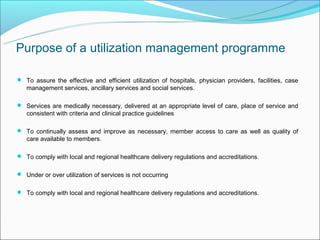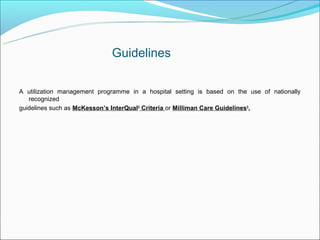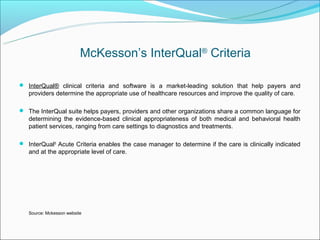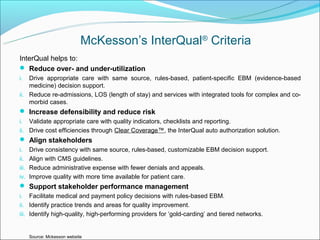Utilization Management
- 2. What is Utilization Management ’éŚ Utilization management is the evaluation of the appropriateness, medical need and efficiency of health care services procedures and facilities according to established criteria or guidelines and under the provisions of an applicable health benefits plan. Typically it includes new activities or decisions based upon the analysis of a case. ’éŚ The Institute of Medicine defines utilization management as ŌĆ£a set of techniques used by or on behalf of purchasers of health care benefits to manage health care costs by influencing patient care decision-making through case-by-case assessments of the appropriateness of care prior to its provisionŌĆØ ’éŚ Standard utilization management services include prospective review, concurrent review, retrospective review, pre-certification of hospital stays, and discharge planning.
- 3. Purpose of a utilization management programme ’éŚ To assure the effective and efficient utilization of hospitals, physician providers, facilities, case management services, ancillary services and social services. ’éŚ Services are medically necessary, delivered at an appropriate level of care, place of service and consistent with criteria and clinical practice guidelines ’éŚ To continually assess and improve as necessary, member access to care as well as quality of care available to members. ’éŚ To comply with local and regional healthcare delivery regulations and accreditations. ’éŚ Under or over utilization of services is not occurring ’éŚ To comply with local and regional healthcare delivery regulations and accreditations.
- 4. Benefits offered to a provider ’éŚ Enhancing the standards and quality of care by providing medically necessary treatment to an appropriate patient group after stratifying the medical risks and instituting timely therapeutic interventions. ’éŚ Multidisciplinary teams collaboration in designing appropriate care pathways, treatment protocols, medical and surgical interventions for a patient group. ’éŚ Reduction in Length of Stay (LOS) resulting in higher patient turnover leading to incremental profits and a higher capacity. ’éŚ Decreased health care spending in avoiding excessive use of healthcare resources without yielding the desired benefit. ’éŚ Tangible cost savings over a period of time by adhering to evidence-based clinical guidelines and doing a periodic utilization review to achieve an optimum state of healthcare delivery. ’éŚ Possible shift in clinical treatment philosophy from medical management to disease management. ’éŚ Efficient resource utilization and improved decision making in investments based on the current utilization rates and patterns.
- 5. Guidelines A utilization management programme in a hospital setting is based on the use of nationally recognized guidelines such as McKessonŌĆÖs InterQual┬« Criteria or Milliman Care Guidelines┬«.
- 6. McKessonŌĆÖs InterQual┬« Criteria ’éŚ InterQual┬« clinical criteria and software is a market-leading solution that help payers and providers determine the appropriate use of healthcare resources and improve the quality of care. ’éŚ The InterQual suite helps payers, providers and other organizations share a common language for determining the evidence-based clinical appropriateness of both medical and behavioral health patient services, ranging from care settings to diagnostics and treatments. ’éŚ InterQual┬« Acute Criteria enables the case manager to determine if the care is clinically indicated and at the appropriate level of care. Source: Mckesson website
- 7. McKessonŌĆÖs InterQual┬« Criteria InterQual helps to: ’éŚ Reduce over- and under-utilization i. Drive appropriate care with same source, rules-based, patient-specific EBM (evidence-based medicine) decision support. ii. Reduce re-admissions, LOS (length of stay) and services with integrated tools for complex and co- morbid cases. ’éŚ Increase defensibility and reduce risk i. Validate appropriate care with quality indicators, checklists and reporting. ii. Drive cost efficiencies through Clear CoverageŌäó, the InterQual auto authorization solution. ’éŚ Align stakeholders i. Drive consistency with same source, rules-based, customizable EBM decision support. ii. Align with CMS guidelines. iii. Reduce administrative expense with fewer denials and appeals. iv. Improve quality with more time available for patient care. ’éŚ Support stakeholder performance management i. Facilitate medical and payment policy decisions with rules-based EBM. ii. Identify practice trends and areas for quality improvement. iii. Identify high-quality, high-performing providers for ŌĆśgold-cardingŌĆÖ and tiered networks. Source: Mckesson website
- 8. Milliman Care Guidelines┬« ’éŚ Milliman Care Guidelines are evidence-based clinical guidelines including care pathways that help providers and payors in effective decision making for the patient care. Milliman Care Guidelines┬« are annually updated, evidence-based clinical guidelines that span the continuum of care, including chronic care and behavioral health management. ’éŚ They are either client-hosted or web-based software that readily interfaces with many medical management and clinical information systems. Interactive version CareWebQI┬« enables quality improvement and cost efficiency through targeting and reducing inappropriate care. It helps in identifying gaps in care and cause of variation thus reducing their occurrences. ’éŚ Indicia┬« for Utilization Review helps clinical teams make admissions decisions and utilization managers justify admissions, level-of-care assignments, and procedures to safeguard reimbursements and meet the challenges of RAC audits. Source: Milliman website
- 9. Overview of a Utilization Management Programme Any Utilization Management programmeŌĆÖs mission is to provide a decision support system for clinicians and managers. It may provide feedback on service utilization to clinicians and managers on behalf of clients. The programme intends to monitor and report on system wide service utilization patterns. It may also provide concurrent utilization review of individual client service needs. ’éŚ UM Plan Clinical Tools Clinical (Medical) Necessity Criteria (Services recommended in the treatment plan must meet all of the following criteria) 1. Treatment must be no more and no less than the client requires based on diagnosis/symptoms/ behaviors/skills/abilities/functioning 2. Treatment is safe and effective according to national standards 3. Treatment is in the least restrictive setting 4. Treatment is cost effective Source: UM Plan for DuPage County Mental Health
- 10. Utilization Review Utilization Review is a process used to evaluate requested health care services and determine if they are Medically Necessary. It is usually of following types: i. Prospective Review ii. Concurrent review iii. Retrospective review Role of Utilization Review is to validate: ’éŚ the necessity of medical service requested ’éŚ if the duration of service requested is within the prescribed range ’éŚ the amount or intensity of service required is appropriate in a given situation
- 11. Standards for Utilization Review These are national standards promulgated by the Utilization Review Accreditation Commission: ’éŚ Collect only the information necessary to certify the admission, procedure or treatment and length of stay for routine reviews. For example, a reviewer shall not routinely request copies of medical records on all patient reviews, or routinely require hospitals and physicians to supply numerically codified diagnosis or procedures to be considered for certification. Firms must limit their data requirements for information on the patient, attending physician, diagnosis, treatment and facility to elements listed by the Utilization Review Accreditation Commission. ’éŚ Establish written procedures to assure timely review and provide notification of certification decisions. For example, the review firm must make certification determinations within two working days of receipt of necessary information on a proposed admission or service. ’éŚ Meet minimum requirements on procedures for expedited and standard appeals of determinations not to certify an admission, procedure, service or extension of stay. For example, a review firm must notify in writing the enrollee or patient, attending physician and claims administrator of its determination on a standard appeal as soon as practical, but in no case later than 60 days after receiving the required documentation. ’éŚ Adopt written procedures on confidentiality of specific patient information. ’éŚ Ensure staff is properly trained, qualified, supervised and supported by written clinical criteria and review procedures, which must be established with appropriate involvement from physicians. ’éŚ Providers must consult with the utilization review service either before a course of treatment is instituted (a precertification review), or on an ongoing basis as the treatment is being conducted (a concurrent review). ’éŚ The utilization review service reviews the program of treatment to make sure it does not include procedures that are either unnecessary or of questionable effect. In addition, utilization review sees to it that when care is necessary, it is provided in the most cost effective way. If the program falls within the standards that guide the utilization review reviewer in making his determination, the treatment will be approved. Source: Utilization Review, ┬®2003 International Foundation of Employee Benefit Plans, Inc.
- 12. Outcomes of Utilization Management ’éŚ Possible enhancement of quality and effectiveness of patient care ’éŚ Possible reduction in ALOS leading to increased profitability ’éŚ Improved healthcare outcomes for the patients providing positive brand value to the provider ’éŚ Predictability in care pathways and treatment measures instituted ’éŚ Reduction in revenue leakages and aligning investment decisions more towards future costs and business efficiency ’éŚ Enhancing competitiveness of the provider











